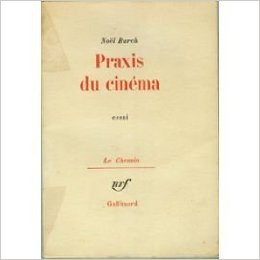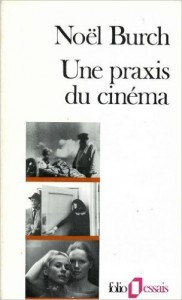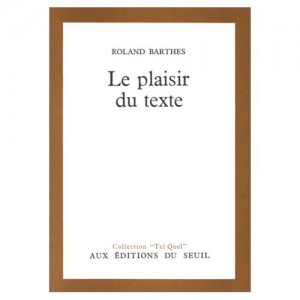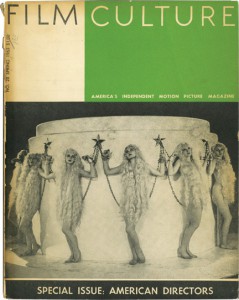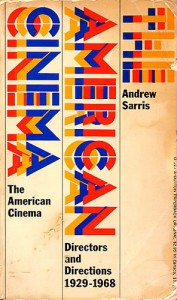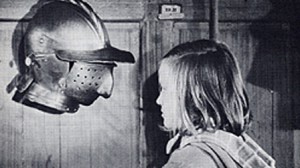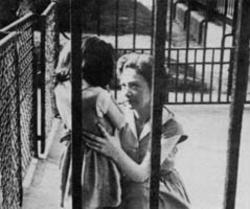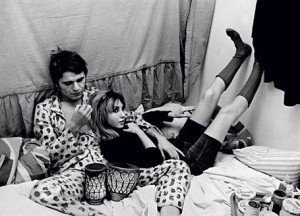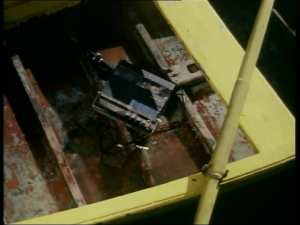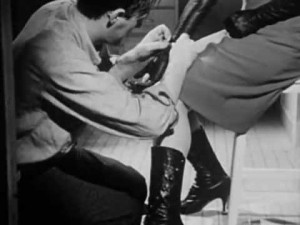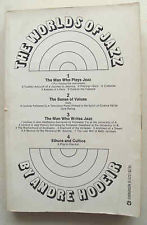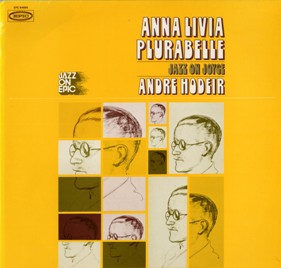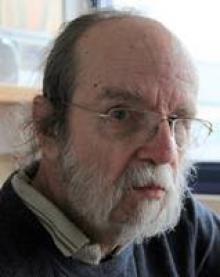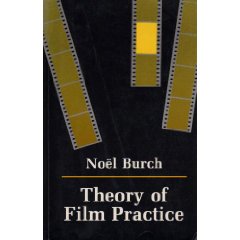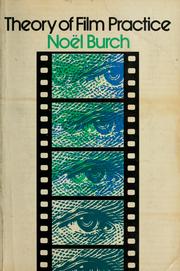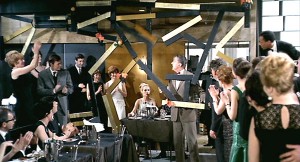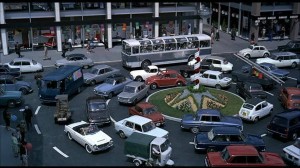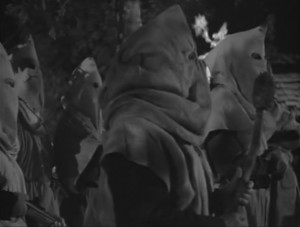For its 100th issue (Winter 2o16), the French quarterly Trafic asked its contributors to select a particular book that had a formative influence on him or her. Here is my contribution. — J.R.
I still have the original Gallimard edition, probably the most tattered and thumbed-through French book that I own, published in 1969, the same year that I moved to Paris from New York — the title missing the article (Une Praxis du cinéma) that is now found on the 1986 edition. I can even recall purchasing this book at Le Minotaure, a Surrealist bookstore on Rue des Beaux Arts, a short distance from my rented flat on Rue Mazarine, and the ridiculous advertising slip (against which Burch rightly protested), “Contre toute théorie,” that enclosed it.
By this time, I’d already read — or at least tried to read, back in New York — earlier drafts of some of the chapters when they had appeared in Cahiers du Cinéma, and may have also read Godard’s praise of one of those chapters in one of his interviews. Due to a crippling disability in learning languages, much of which I still suffer from today, I had to read those chapters with the aid of a French-English dictionary, even though Burch’s French—the French of an American émigré — was far easier to follow than the French of Roland Barthes in Le plaisir du texte, published four years later, which eventually became my other key French text of this period. But Burch’s text, because it dealt with cinema throughout, was something I was using differently, as a partial guide to my film viewing in Paris, much as I was also using Andrew Sarris’s entries on directors in The American Cinema when they appeared first in Film Culture (Spring 1963) and then in an expanded book (1968) — as a catalogue and checklist, where I could check off the title of each film that I saw in the index (or, in the case of Sarris’s book, underline the titles in the filmographies). It was Burch’s book, therefore, that partially mentored my early viewings of Hôtel des Invalides, Une simple histoire, L’amour fou, Le Horla, and even Burch’s own first film, Noviciat (1964), which in seventeen minutes manages to encompass more of the formal procedures described in Praxis du cinéma than any other film. (By this time, I had already discovered Bresson, Tati, Resnais, Godard, and even Rivette’s first feature on my own, but Burch’s commentaries on the first four — and his early essay on Buñuel’s Le Journal d’une femme de chambre [published, I believe, only in English, in the third and final issue of the short-lived Moviegoer] — certainly helped to enhance my appreciations of them.)
The value of Praxis du cinéma to me was of course radically different from that of The American Cinema — indeed, these two books formed something close to a transatlantic dialectic in my film education, a dialectic between form and style. And for me, the formal concerns of Burch at the time were closely allied to my passion for jazz and my interest in André Hodeir, three of whose books Burch translated into English: Since Debussy (1961), Towards Jazz (1962), and The Worlds of Jazz (1972). And it was the last of these and Hodeir’s musical masterpiece, Anna Livia Plurabelle (1966), that interested me the most — both of them idiosyncratic, dialectical hybrids of jazz and literature that passionately embraced form more as a verb than as a noun. (When some of the multiple puns of Joyce from Finnegans Wake are seemingly “mispronounced” by the two singers in Hodeir’s Anna Livia Plurabelle, there is always a musical justification in their formations.)
I’m well aware that Burch’s political awakening after May 1968 led him first to critique Praxis du cinéma (in the Preface to the 1973 English translation, Theory of Film Practice), then to disown and denounce it (in his 1980 Foreword to the second edition, which begins, “’I’ am not the author of this book,” and then goes on to castigate its contents as “[a] formalism of the worst kind, which might also be called ‘musicalism’ or, perhaps most precisely, flight from meaning”). But at the same time, I’ve never learned nearly as much from Burch’s subsequent writing, and I was already struck in the early 1970s by the fact that the people I read and/or knew in Paris who had the most interest in and sophistication about formal issues in cinema—including some acquaintance with the Russian formalists — tended to be members of the PCF: above all, Jean-André Fieschi (who cofounded with Burch and Daniel Manciet l’Institut de Formation Cinématographique in 1967), but also such friends as Bernard Eisenschitz and Eduardo de Gregorio. This fact is undoubtedly less surprising to French readers, but for an American child of the Cold War whose leftist friends and colleagues in the U.S. tended to be either indifferent or hostile towards formal issues, it was a revelation. And not so much a “flight from meaning” as a tool box for exploring certain forms of meaning in greater depth.
Meanwhile, some of my cinephile acquaintances in the U.S., such as David Bordwell and Noel Carroll, pointed out that many of Burch’s examples were in fact errors. (Burch himself acknowledged this fact in his 1973 Preface and in footnotes to that edition, arguing in a couple of cases that these errors were worth retaining as “imaginary examples”.) But for me, both in Praxis du cinéma and in some of Burch’s subsequent texts, I came to regard such errors as a form of science-fiction in relation to film theory that was often far more stimulating and fruitful than the more correct writings of his academic critics.
By the time the English translation was published by Praeger in the U.S. and the U.K. in 1973, with an Introduction by Annette Michelson, it had become a cause celèbre for me, and I wound up reviewing the book twice, initially for Sight and Sound (Winter 1973/74) and shortly afterwards for the Village Voice (February 28, 1974). The first two quotations (and two paragraphs) below come from the former review, and the third (and the final four paragraphs) come from the latter:
“The material to be found in this deceptively short book is rich and penetrating indeed, and in nearly every case the procedure singled out is far from the obvious textbook exhibit (e.g., the stone lions in Potemkin, the cockatoo in Citizen Kane). Each example is a genuine discovery: the crucial function of off-screen space in Renoir’s Nana, chiefly made evident by the actors’ entrances into and exits from the frame; permutations of the positions occupied by the actors from one shot to the next in the first half of Kurosawa’s High and Low; the subtle and dramatic integrations of sound effects with music in Mizoguchi’s The Crucified Lovers; the remarkable ‘structure of variations’ in the opening and closing of doors in the dressing-room complex of The Blue Angel, controlling what is audible or inaudible from the music hall; the deliberate rhythmic alternation between ‘strong’, active and eventful moments, and ‘weak’, empty and boring ones in Mr. Hulot’s Holiday, with each sequence composed as an independent ‘cellular’ unit; the progression of Lang’s M from ‘temporally and spatially autonomous’ shots to ‘an increasing use of the continuity cut, finally culminating in the famous trial sequence in which temporal and spatial continuity are strictly preserved for some ten minutes.’ Each of these examples suggests not only an underlying pattern which is relevant to the film at every level (thematic, dramatic and psychological as well as ‘technical’), but also a central insight into how the film as a whole works.”
“One must protest, however, the shabby treatment this English text has been given by its publishers. Quite apart from the use of a production still from Lang’s You Only Live Once on the cover of the English edition — odd indeed considering Burch’s disdain for Lang’s American films, and scarcely relevant to anything inside the book — the copy-editing of the text frequently borders on the risible. To misappropriate a few of Burch’s terms…the footnotes to the final chapter are a series of ‘mismatches’ (after an earlier footnote introduces us to one Millar Gavin), while the demented index — which offers us a mysterious True Confessions and an even more mysterious chap named Edmond Genet, but omits dozens of important references to films and film-makers, including every mention of Tati and Dreyer — can only be regarded as a ‘structure of aggression’.”
“It seems oddly appropriate that Theory of Film Practice should appear in Cahiers du Cinéma that same year (1967) that Playtime opened in Paris, and also that they should arrive in America at approximately the same time. Films that re-define the language and syntax of cinema are rare in any period, and it is hardly surprising that books that do the same are even less common.
“Both works, emerging out of years of reflection, stand defiantly apart from the surrounding landscape, inviting us to share that broad perspective. Each offers us a fresh garden of possibilities in the midst of a familiar terrain by drawing us into a kind of creative collaboration that requires, at least implicitly, that we become film makers.
“In Playtime, along with the film’s characters, we are taught that the way to live in planned space and make it our own is by re-forming it, e.g. carving our own compositions out of Tati’s generously over-abundant ones. This concept becomes apotheosized as a marvelous metaphor in one of the closing shots, when, to the tune of a climactic refrain in the merry-go-round muzak score, a worker’s crane sweeps majestically into view, and the joy of the tourist who has located himself becomes the exhilaration of the director scanning his own world.
“Although its form of discourse is obviously quite different, the pleasure of discovery afforded by Theory of Film Practice is not dissimilar. Burch’s book treats film-viewing and filmmaking as parts of the same integral process: ‘Our purpose is on the one hand to make cinema and on the other hand to watch it,’ he specifies in his conclusion to the French edition, ‘but to watch it as we make it — that is, as a perceptible reality.’ Properly speaking, Tati and Burch don’t so much re-define cinema as provide new data and relationships which goad us into re-defining it for ourselves.”
Two belated afterthoughts to these quotations seem worth noting: (1) The use of italics to give needless, hectoring emphasis to certain arguments — in Burch’s prose (in the penultimate sentence of the sixth paragraph) and in my own prose (in the final phrases of the first and fourth paragraphs) — is a good example of the negative effect and influence (or, should I say, negative effect and influence?) that Burch’s writing had on my own prose at the time. (2) By 1974, I had moved to London, and when I met Burch there for lunch one day, I discovered that my objection to the production still from You Only Live Once on the cover of the English edition was not at all shared by him. Here again, this led me to rethink some of my own biases and reflexes when it came to evaluating Burch’s writing.
And of course I had disagreements with some of his positions from the outset — especially with his overestimation of Alain Robbe-Grillet as a filmmaker (despite our shared admiration for L’Année Dernière à Marienbad), his rants against MacMahonist favorites such as Ford, Minnelli, and Walsh in his “Conclusion” (a section tactfully omitted in its entirety from the English edition), and his insistence in the same section that commercial restraints in Hollywood virtually guaranteed a regression rather than an evolution in the work of talented directors. (“Samuel Fuller a-t-il fait un meilleur film que I Shot Jesse James? Nicholas Ray que They Live By Night? Robert Wise que The Set-Up?”) Moreover, in his 1973 Preface, he maintains that his book “tends to decline more or less steadily as it progresses, especially from Chapter 8 on,” whereas for me, the most fruitful and interesting chapters are still probably 6 through 8 (“De l’usage structural de son,” “Fonctions de l’aléa,” et “Structures d’agression”). But in Sarris’s The American Cinema, I was no less skeptical about the skirting and/or misreading of social and political issues in the work of such directors as Fuller (who was mistakenly called “primitive” as well as right-wing), Ray, and Sirk, the imperialist misappropriation of British directors as belonging to American cinema, the undersestimations of Kazan, Lewis, Mamoulian, Mankiewicz, Tashlin, Jacques Tourneur, Wellman, and Wilder (among others), and the omissions of such figures as John Berry and Cy Endfield.
In the final analysis, Burch is (mainly) a filmmaker and teacher and I’m (mainly) a journalist, so it’s only logical that our values and priorities should differ; we’re both basically self-taught bricoleurs when it comes to cinema, but we go about our bricolages in very different ways. To very different degrees, we’re both ambivalent Americans strongly attracted to and influenced by French culture, but we carry this baggage very differently. What I finally value in Praxis du cinema are the paths it opened up to me so that I could forge my own trajectories.

